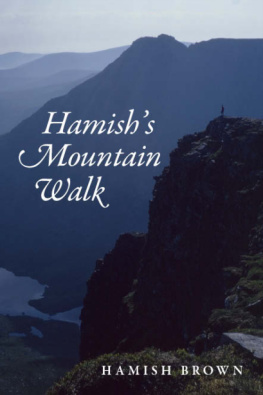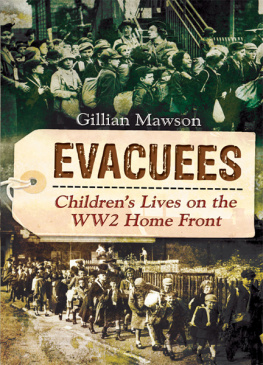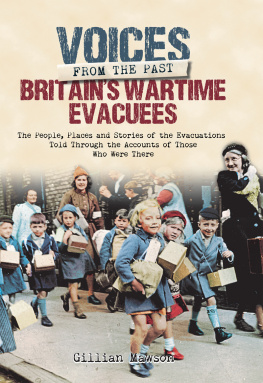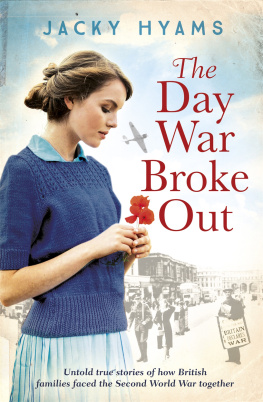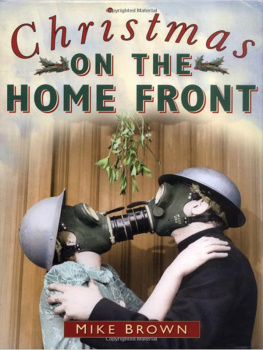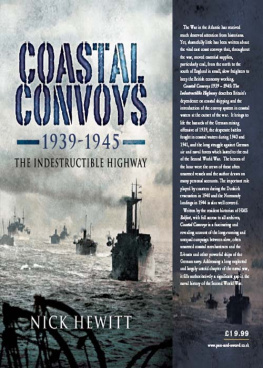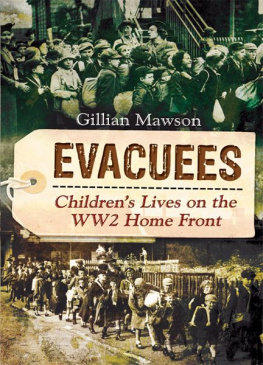EVACUEES
EVACUATION IN
WARTIME BRITAIN
19391945
MIKE BROWN

First published in 2000
Reprinted in 2010 by
The History Press
The Mill, Brimscombe Port
Stroud, Gloucestershire, GL5 2QG
www.thehistorypress.co.uk
This ebook edition first published in 2013
All rights reserved
Mike Brown, 2010, 2013
The right of Mike Brown to be identified as the Author of this work has been asserted in accordance with the Copyrights, Designs and Patents Act 1988.
This ebook is copyright material and must not be copied, reproduced, transferred, distributed, leased, licensed or publicly performed or used in any way except as specifically permitted in writing by the publishers, as allowed under the terms and conditions under which it was purchased or as strictly permitted by applicable copyright law. Any unauthorised distribution or use of this text may be a direct infringement of the authors and publishers rights, and those responsible may be liable in law accordingly.
EPUB ISBN 978 0 7524 9572 9
Original typesetting by The History Press
Contents
Acknowledgements
I would like to take this opportunity to thank the following people who so kindly shared their memories with me:
Audrey Wines ne Arnold, Evelyn Fisher ne Baker, Shirley Symons ne Barry, Vera Biddle, Arnold Beardwell, Jane Black, Pamela Nicolle ne Buckley, Christine Castro ne Pilgrim, Mrs R. Channing, Lavender Baskett ne Clarke, Lillian Clegg, June Wolfson ne Cohen, Betty LeBail ne Collas, Jennings ne Cordell, Kathleen Corton, Rita Kirk ne Curtis, Philip DArthreau, Kenneth Dobson, Jennifer DEath, Tom Dewar, Bryan Farmer, Joyce West ne Fry, Betty Sutton ne Gagg, Jean Barber ne Garnham, Rozel Garnier, Iris Knudsen ne Gent, Frances Lloyd ne Hardy, Edward Harrington, Ann Headley ne Peppercorn, Enid Helyer, Doreen Ramsenius ne Hooper, Ann Beardwell ne Honey, Betty Hull, Walter Hurst, Nita Luce ne Jenkins, Betty Judge ne Jones, Roy Judge, Mavis Burren ne Kerr, John Kirk, Doreen Last, Iris Tilman ne McCartney, Miriam McLeod, Brian Martin, Peggy Mayhew ne Masterson, Alice Bott ne Morgan, Ursula Nott, Mary Facey ne Noyle, L. Powis, George Powis, Christine Jones ne Pring, Roy Proctor, Ernie Prowse, Iris Prowse ne Miller, Henry J. Ramagge, Joan Letts ne Rands, Betty Easter ne Robinson, Eddie Roland, Clarice Ruaux, Doug Ryall, Archie Salvidge, Eric Sephton, Mrs Sewell, Vera Sibley, E.A. Roy Simon, Mary Kingham ne Spink, Linda Toomey (ex-Stebbing), Joan Stone ne Stephenson, Joyce Stockton, Margaret Thompson, Margaret Durham ne Watling, W.J. Wheatley, Caroline Williams, Joyce Withers, David Wood, Donald Wood, Margaret Woodrow, Mrs M. Worner ne Phizacklea, Mr S.A. Yates.
I am grateful to Andy Mathieson for the use of Stillness School log, and Margaret Baker for kindly allowing me to use excerpts from her father, Fred Bonds unpublished memoirs.
My thanks also go to the following who allowed me to use illustrations:
Joyce Fry, Roy Judge, Iris Miller, Doug Ryall, Phyllis Sewell, June Wolfson, Margaret Woodrow, Donald Woods, Margaret Thompson, Joseph Morello, Bromley Local Studies Library, Hull Central Library, Kent Messenger Group Newspapers, London Metropolitan Archives, Southwark Local History Unit.
INTRODUCTION
Bloody Vackees
During the final days of peace in 1939 a massive exodus took place throughout the country. Nearly two million civilians, most of them children, were taken from the cities, industrial towns, and ports of Britain to the relative safety of the countryside, using trains, buses, trams, coaches, and even pleasure steamers. For many of the children it was the first time away from their families, for some the first time outside their town. They went, carrying a few belongings, not knowing where they would end up when a group waiting at a London station were asked where they were going, one child replied, We dont know, sir, but the King knows. For some it was the beginning of a great adventure, for others a nightmare. This was the first great evacuation, but not the last. During the course of the war there were to be two more and, in between, a constant flow of individuals and groups both into and out of danger.
This mass evacuation was the result of planning going back to the early 1920s; progress was sometimes painfully slow, sometimes almost in a panic, depending on the mood of the international situation. It has often been repeated that the evacuation programme went off with no hitches, but this is more what was reflected by the widespread propaganda at the time, aimed at reassuring those parents who had sent their children and encouraging those who had not. But there is no doubt that evacuation saved thousands of lives; up to the end of 1942, only twenty-seven children evacuated from London were killed in air raids, a tiny proportion compared with casualties among those who remained, the majority of whom were not physically hurt but many of whom suffered for years from the psychological effects of the bombing.
A large number of the evacuees were from the slums and tenements of the inner cities; some of the householders who took them in were given an insight into a world of poverty which many assumed had disappeared with Queen Victoria. The outcry that followed led to the Beveridge Report and todays welfare state. On the other hand, many of the evacuees were given an insight into the world outside the cities, of farms, countryside, and animal husbandry, which encouraged some to stay there after the war, and left many with a life-long love of the countryside.
The mass evacuation of the inner cities was an exercise which changed a generation, if not the whole country. Using contemporary documents, and the words of those who experienced it, I have tried to trace the story of the evacuation, the planning, the first attempt at the time of the Munich Crisis, and then the real thing. Then came the phoney war and the drift home, which soon became a flood, but for many their evacuation was a more permanent affair and many were to experience both the problems and the joys of billet life before they could finally return home.

Boys from Rochester Mathematical School starting their own Great Trek. Notice the gas masks, especially the cloth case on the left, and the evacuation label. (Kent Messenger Newspaper Group)
ONE
How It All Began
As with so many aspects of the Second World War, the roots of evacuation can be traced back to the First World War. The first air raids on Britain began as early as 1914, with London being bombed for the first time in May of the following year. During the course of that war, fourteen hundred civilians were killed in just over one hundred raids, first by Zeppelins, then by heavy bombers. The citizens of Britain, generally secure from enemy action for almost a thousand years, now found themselves vulnerable, and became more so with each advance in aviation technology, in an inter-war period marked by record-breaking long-distance flights by such people as Charles Lindbergh, Amy Johnson and Amelia Earhart, and air races, such as the Schneider Trophy.
Less than three years after the signing of the Versailles Treaty the Air Raid Precautions, or ARP Committee was set up to examine the problems posed by air raids. Included in the topics for discussion suggested by the chairman, Sir John Anderson, at its first meeting in May 1924 was the possible evacuation of sections of the civilian population. The committees earliest investigations into evasion, or evacuation as it came to be known, hinged on the premise that London, as the capital, would be the principle target of air attacks. The ARP Committees first report in December 1925 established two basic points:






